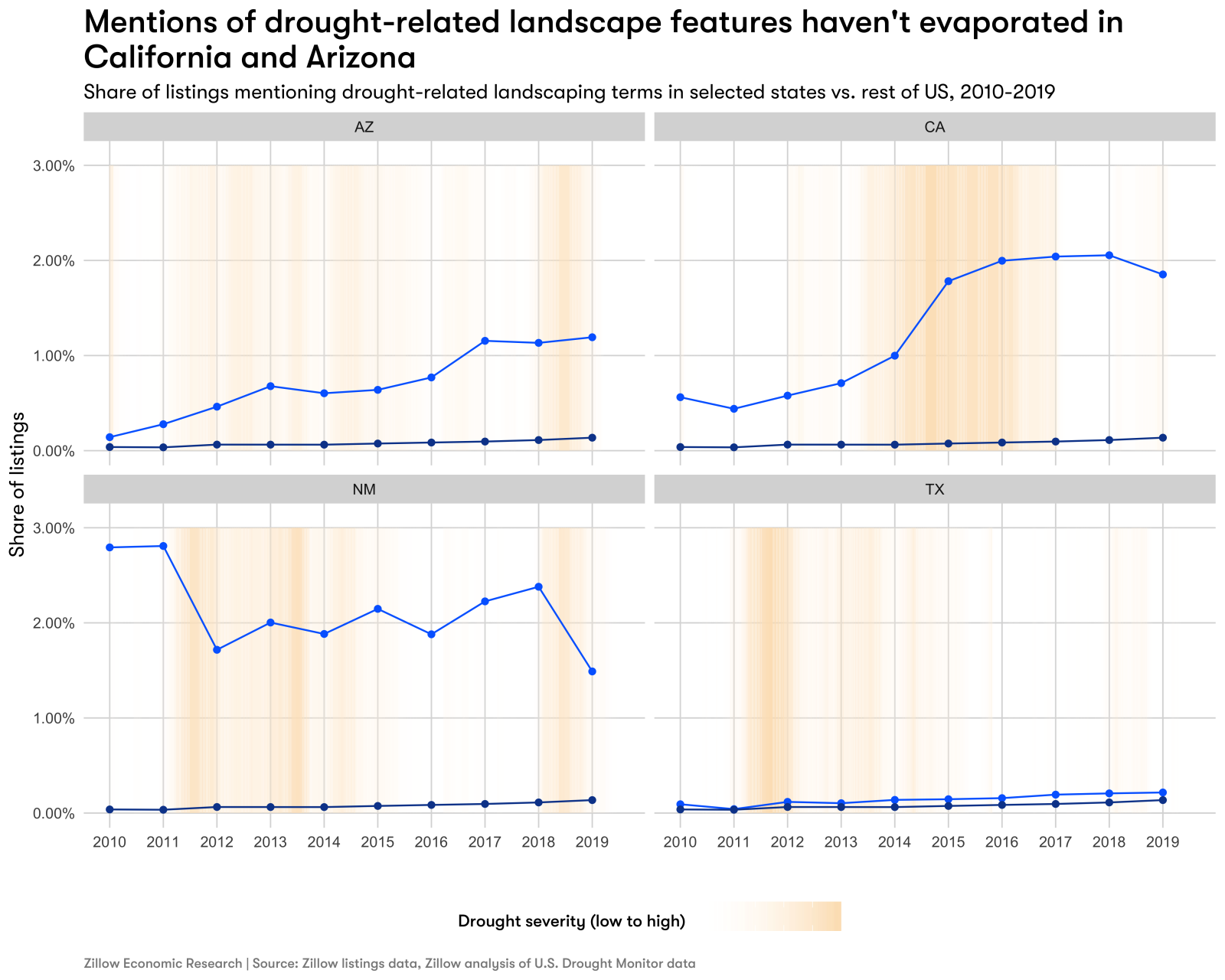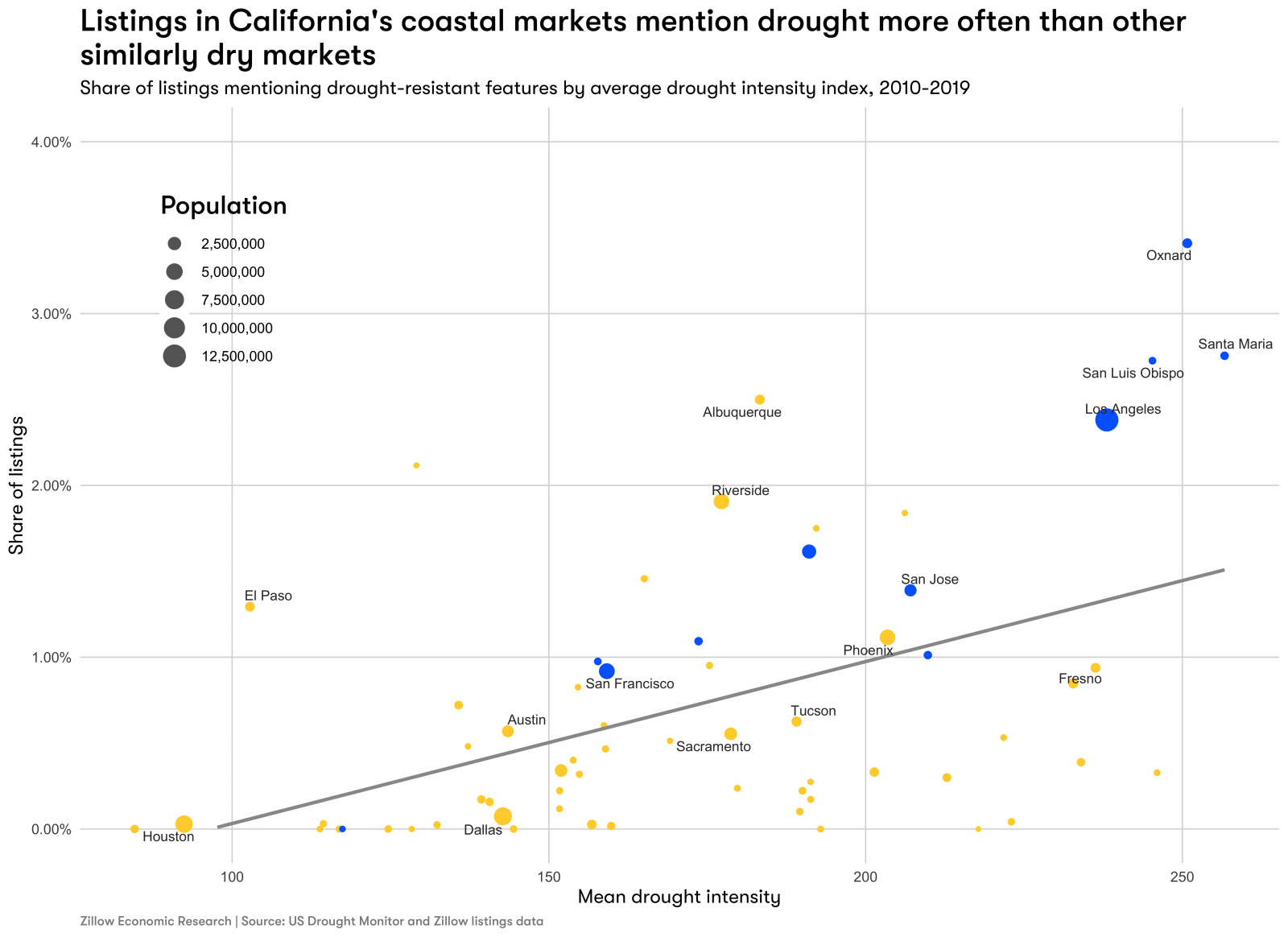- Mentions of drought-resistant features in home listing descriptions roughly doubled in California and Arizona during the recent drought, and have yet to return to pre-drought levels.
- Environmental norms could explain some of this trend: California's coastal markets have the highest share of listings that mention drought-tolerant features, even though the drought was no more severe there than in markets farther inland.
After the wettest 12 months in U.S. history, the threat of drought might seem like a mirage. But the frequency with which drought-resistant features are mentioned in home listings is still elevated in hard-hit western states, suggesting that these features remain desirable for home buyers even as drought pressures have eased.
What are drought-resistant landscaping features?
Around a quarter of water consumption among single-family residences goes to outdoor use, but in hotter, drier parts of the country, outdoor water usage can be twice that in wetter areas. In places that don't get much rain, maintaining a lush green lawn can suck up tens of thousands of gallons of water per year – a heavy environmental burden. In fact, some researchers argue that lowering outdoor water use has the greatest potential for urban water savings.
Instead of conventional grass lawns, the U.S. Environmental Protection Agency (EPA) recommends choosing native plants that require water only from normal rainfall, using mulch to help aid water retention, and installing water-efficient drip irrigation systems. Alternatively, homeowners can replace their lawns with artificial turf, saving on yard maintenance costs as well as water use.
Under normal circumstances, maintaining a conventional lawn might not seem expensive, especially when compared with the upfront cost of converting to more water-efficient landscaping. But when state and local governments impose conservation measures or offer incentives to help save water during droughts, that financial calculus can change. What's more, social pressure to conserve water also can motivate people to make the switch – after all, most people don't want their neighbors to think they're irresponsible water-guzzlers.
It's not hard to imagine that both these forces would be temporary, with interest waning once normal rainfall returns. However, an analysis of home listing descriptions tells a different story.
Drought-related terms are still popular in California and Arizona, but they never took off in Texas
California and Arizona both saw an uptick in mentions of drought-resistant features[1] during or after periods of intense drought. Since the end of the California drought, that spike tapered somewhat but has remained elevated.
Meanwhile, New Mexico and Texas – both of which experienced drought in 2009 and early 2010 – show disparate trends. Mentions of drought-resistant features in New Mexico were consistently high over the last decade, but have dropped recently, while listings mentioning these features in Texas remained few and far between.
Of course, the share of listings that mention these features probably doesn't reflect their actual prevalence across different geographic areas, because their presence is less likely to be notable in drier climates. But an increase in mentions over time could signal that they are becoming more common, or at least more in-demand.

Different vocabulary in different states
Listings in different states use somewhat different terms in reference to these features, perhaps providing a clue to whether environmental motivations are at play. The phrases "drought friendly," "drought tolerant," and "drought resilient" are most common in California, whereas the term "hardscape" has much wider geographic reach, with mentions appearing in along the East Coast states and in the Southwest. Meanwhile, the technical term "xeriscape" crops up in New Mexico and Colorado. And in Georgia, which also experienced a drought in the last decade, mentions of drought are often in reference to lakes that are deep enough that homeowners can continue to use their docks during dry spells.
Environmental values might play a role
California's coastal markets have the highest share of listings that mention drought-tolerant features, even though the most recent drought was no more severe there than in markets farther inland. For example, Los Angeles experienced roughly the same average drought intensity as Fresno, but its listings mention drought about twice as often. This geographic pattern could reflect a stronger culture of environmentalism along the coast. And greater environmental awareness might also help explain why mentions of drought-resistant features have remained high even after the drought.
Data from the California State Water Board show that the state's coastal regions also have had lower residential water use per capita than its inland regions, although it's worth noting that per-person water use inland dropped by much more during the drought.

While drought concerns are sporadic right now, recent research indicates that climate change will make rainfall less frequent (but more extreme when it does happen) in California and other West Coast states. In combination with rising temperatures, which tend to increase landscaping-related water needs, this greater variability could make investing in more sustainable landscaping now a smart financial move as well as an environmentally friendly one.
[1] The list of terms includes the following words or phrases: drought tolerant, drought resistant, drought resilient, drought friendly, drought proof, xeriscape, hardscape, gravel landscaping, gravel beds, tan bark, desert garden, desert plants, artificial turf, artificial lawn, and artificial grass. This list was generated from common terms referenced in guides to improving landscaping's water efficiency, and also used regular expressions to account for slight variations on the exact term.
The post Drought-Resistant Terms Doubled in California, Arizona Listing Descriptions appeared first on Zillow Research.
via Drought-Resistant Terms Doubled in California, Arizona Listing Descriptions

No comments:
Post a Comment